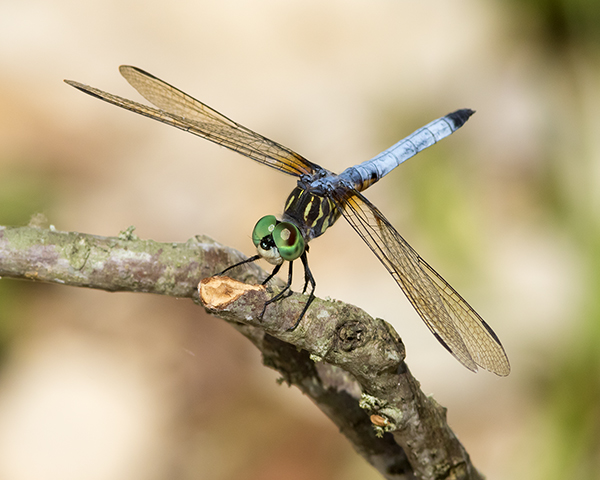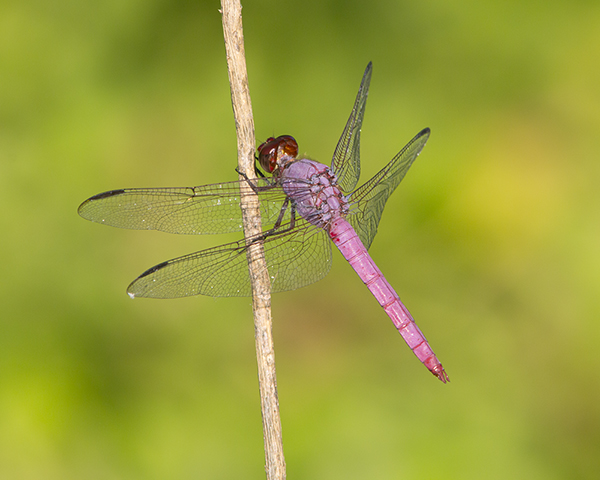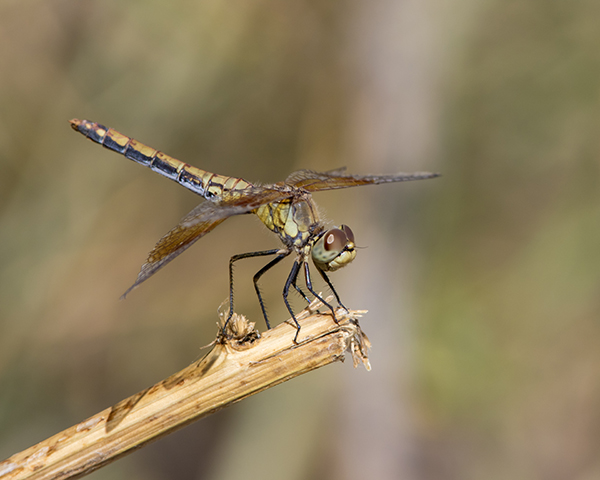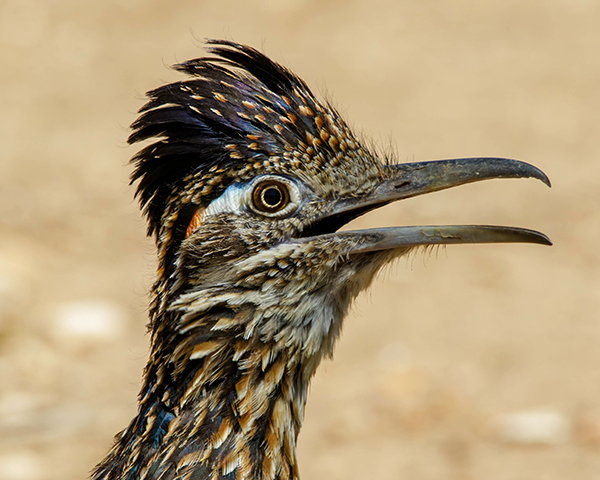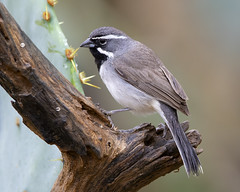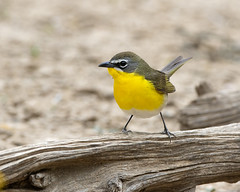I try not to make the same mistake twice.
Last year we made a mistake. Really two mistakes.
Our primary mistake was trying to shoot in bird blinds two days in a row. Shooting in a blind is mentally taxing. We paid for it in terms of our performance on the second day.
Adjacent to that mistake was cutting our afternoon short at the Rocking R6. We thought if we got started heading north to Uvalde a little earlier it would help the following day. It didn’t. And we deprived ourselves of the golden light that accompanies sunset.
This year we did it differently. We stayed as long as my hand could stand shooting with the big lens. And then rather than trying to drive to Uvalde we instead drove back to the hotel in Cotulla. We had a quick meal at one of the fast food establishments on the highway. And we called it a night.
Monday was a workday for my shooting partner, and she put in about five hours before we called it good. We grabbed a bite to eat on the way to Cotulla and rolled in around check-in time for the Airbnb we had rented. In previous years we stayed at the Hampton Inn in Uvalde, but the prices had gotten so expensive for reasons that are somewhat political and I won’t go into here. So instead at about half the price we used the Airbnb. That was not a mistake.
I had contemplated going out to Cook’s Slough Nature Park that afternoon to do a little photography, but I was fatigued enough after the drive and the light was just kind of so-so, so we didn’t do it. Also not a mistake.
We had a sit down meal in Uvalde, watched the Johnny Carson channel on Roku TV, and called it a relatively early night.
Much better decision making this year.
Texas Photo Swing 2024: Day 2 – Rocking R6 Ranch
The alarm came early on Sundary morning. It always does.
We returned from the restaurant the night before with thunderstorms brewing. The rain was still very much in the area as we left.
This was not the first time I’ve headed to the Rocking R6 with rain on the travel down. This time, unfortunately, it stayed with us quite a while. Rain more or less stayed with us for the entirety of the day, though we did eventually get some good shooting in.
First and foremost, it is always great to see Butch and Zita. I’ve visited with them each of the last 11 years. It is always beyond a pleasure to spend time with them.
My shooting partner and I got to spend more time with them inside than normal as the rain seemed like it would never let up. Eventually it got to the point where we could at least get out and we wandered to the Cactus Blind. It was there that I realized how much I missed the Tamron 150-600mm. The Cactus Blind is a very intimate blind and I found most of what was available to me was just too darn close. Now the upside was what I could get into my minimum focusing distance I could shoot at a much shorter exposure because of the difference between a minimum f-stop of f/4 as opposed to f/6.3. I only made about 150 shots in that blind because of the low light conditions and because how close everything was. But I did get at least 2 keepers out of the morning: A Black-throated Sparrow and a Brown-headed Cowbird.
We headed in for lunch and after an amazing meal and a much-appreciated nap. Once we shook the sleep out of our eyes we headed out to Butch’s new afternoon blind. Before Butch could complete all of the prep work, I already had one keeper: A Curved-billed Thrasher that perched up on a tree above the water drip.
Throughout the afternoon the sun would try to peak through, but often accompanied by rain to knock down the light again. It is spring in Texas. The weather isn’t going to always be perfect.
There were three stars of the afternoon sessions.
First were the ground birds: Norther Bobwhite quail and Greater Roadrunners. The two Greater Roadrunners and the group of up to 10 Northern Bobwhite put on quite a show.
And in the trees the star was the Brown-crested Flycatcher. Beautiful subtle grays, yellows, and browns in that bird. Made quite a few frames of that bird.
For the day I caught 16 species on my camera: Red-winged Blackbird, Mourning Dove, Inca Dove, Brown-headed Cowbird, Black-throated Sparrow, Northern Cardinal, Curve-billed Thrasher, White-tipped Dove, Green Jay, White-winged Dove, Northern Bobwhite, Brown-crested Flycatcher, Golden-fronted Woodpecker, House Sparrow, Greater Roadrunner, and Painted Bunting. Add a Mexican Ground Squirrel to the mix, and it was a nice assortment of different birds.
By the time it was said and done I’d put a little more than 2200 images onto the cards. Not a bad day of shooting, I’d say. Especially considering the weather. I’ve not finished my review, but I’m at 29 images I want to try to process and I’ve already put 4 in the portfolio.
We can’t wait to see Butch & Zita again next year.
About the Image
Northern Bobwhite (Colinus virginianus)
Webb County, Texas – April 2024
Canon 7D Mark II, Canon EF 600mm f/4L IS Lens
Tripod w/Wimberley gimbal head
ISO 400, 1/100 at f/8 – No Flash
Portfolio Image #1597
Image Size in Portfolio: 3968×3174

This is my 4th full year of being away from San Antonio. Each of the previous three years I have made a trip into South Texas to do some photography.
In 2020, my trip was precipitated by selling the home that myself and the woman to whom I am no longer related to through marriage had owned at the time. As luck would have it, that trip occurred before Covid took over our world.
In 2021, the trip was made shortly after the Texas Snowmageddon, leading to a unique mix of birds. It was also the first trip where my current shooting partner and I spent time in a bird blind together. We also had the opportunity to spend two extra days in San Antonio when Colorado experienced a storm with upwards of 4 feet of snow on the day when we were supposed to return.
In 2022 the trip was made in May, timed to bring my daughter to her final resting place with the help of a group of outstanding people that watched her grow up, and on a day appropriate to her personality–“May the 4th be with you.”
And last year we enjoyed two days of decent weather in bird blinds before the rest of the trip was clouded in and again was delayed in San Antonio for a spell on our way to a training course.
This year was going to be a little different.
One more ranch to visit. A rented lens that I’d never used before. Very little time schedule in San Antonio and the first year where we didn’t stay at our favorite Courtyard hotel that I’d been to each of the previous 4 years. And a left hand in a splint after falling on my way to light rail a couple of weeks ago.
Planning for this year’s trip started all the way back to about November. Contacting ranch owners to make sure the dates we wanted would work for them. Arranging flights, rooms, and a rental car. And making a decision between buying a lens or renting a lens. I went with renting a lens.
This was supposed to be the second trip of the year. Unfortunately, our first trip, a train photo charter at a railroad in Tennessee, was cancelled. Missing that trip was disappointing for two reasons. First was getting a chance to make images of another steam locomotive. But second was just getting a chance to shoot before this big trip.
Our travel day was not what I had expected or hoped for. I had to be in the office in the morning. The company I work for has mandated three days a week in the office or at a client location, with one of those three days having to be on a Monday or a Friday. Circumstances made Monday impossible to be in the office for, so Friday it was.
It started to snow a little bit as I was headed from the office back to the house. That wasn’t supposed to start until after we had gotten on the plane and headed for San Antonio. I knew that was going to be an impediment to progress.
By the time we got to the airport there were a couple of inches on the ground. Nothing special, but as our evening progressed it was obvious that a little bit of snow without the proper folks at the airport was going to cause our night to be longer than expected. An hour plus on the ground waiting for deicing turned our expected arrival into San Antonio at a little before midnight and arrival at the hotel a little after midnight into a 2AM arrival at our go-to hotel at the airport. We were late enough that the hotel’s computer had a difficult time getting us checked in because it was already at a point where it would be ready to do the automatic check out.
After a very short night, we went through our somewhat usual routine:
- Get our rental car–San Anotnio’s rental car concession closes at midnight
- Eat breakfast at the Cracker Barrel just down the road from the airport
- Grab some provisions for the rest of the trip: Snacks, drinks, and the like
- Get an equipment check shoot in at the bird blind at Crescent Bend Nature Park
- Head down the road to Cotulla
The equipment check is always important because once we leave San Antonio what we have for gear is what we have for gear. If something isn’t working, we are, as my dad would tell me, shucks out of luck.
The difference this year was renting the lens. We made a quick run just down the road from the hotel to Camera Exchange. I have a long-running relationship with Camera Exchange. I bought my 7D Mark II there. I bought my Tamron 150-600mm at Camera Exchange. I’ve rented lenses and a flash for them before. I am a fan of shopping local. There are plenty of options to rent online. There are plenty of options to buy online. But I want to support my local camera stores. So weeks ago I went reserved my lens for the trip: A Canon 600mm f/4 L IS lens.
Honestly, I had no idea how big this thing was until the gentlemen behind the counter brought out the carrying case. Twenty-three pounds of Canon glass. With only one fully working hand I knew that this was going to be awkward. It was. But preview of coming attractions, the results were worth the awkwardness.
After getting the lens we went over to Crescent Bend for the aforementioned ops check. As it turns out, this was a good idea. The batteries I thought I had charged ahead of time I had not. I had but one battery with any power in it, and that was only about 60%. That would have been awkward the following morning. Otherwise, everything else worked just fine.
The lens was admittedly awkward to get on and off of the gimbal head. And somewhat awkward to get back into the case.
After a little less than 200 shots, we got back into the car and made the trek down to Cotulla to spend the night and make the drive to and from the ranch on Sunday a little less hectic.
Once we got to the hotel we got settled in for our two day stay, got batteries charged, grabbed some dinner, and then called it a night. We would be up very early the following morning to get to the Rocking R6. And sadly weather was not looking favorable.
About the Image
Carolina Wren (Thryothorus ludovicianus)
Bexar County, Texas – April 2024
Canon 7D Mark II, Canon EF 600mm f/4L IS Lens
Tripod w/Wimberley gimbal head
ISO 800, 1/320 at f/7.1 – No Flash
Portfolio Image #1611
Image Size in Portfolio: 3524×2819
Even Paranoid People Have Real Enemies
Most of you who have followed this blog over the years know that I earn a living as a cybersecurity professional. And as a cybersecurity professional I’m paid to be paranoid.
This paranoia extends into my personal life. I’m paranoid about backing up my photos. I’ve lived by the mantra “What a tangled web we weave when in backups we do not believe.” Images are backed up in a lot of places and backed up often.
I’m also paranoid about sharing online when I’m on the road. So I don’t. No Facebook posts. No living immediately vicariously through immediate blog posts. Too many ways for nefarious actors watch for Facebook posts to figure out how they’re going to go shopping at your home at highly discounted prices.
Which is why I’m about to start my series of blog posts about being on the road for our annual photo swing to south Texas more than a week after returning home. Sure, I could have scheduled blog posts to start posting when I got home, but I also don’t process images on the road.
So now that I have returned and now that I’ve started processing some images, enjoy living vicariously through my travels, if only a week later.
Caught Up… In Time To Be Behind Again
I have reached an odd time in my journey to get caught up on my processing. Yesterday morning, waiting for an online cribbage tournament to start, I achieved something I’ve never managed to accomplish. All of the images I have shot with a long-term camera have been evaluated and the keepers have been processed.
That camera is my Canon EOS 7D Mark II. It is the one that I still shoot today, though it is likely I will retire it as soon as at the end of this shooting season.
My last image to get my caught up was the Blue Dasher (Pachydiplax longipennis) that leads this blog post. It was frame number 331 on a day in late August 2015. That shooting day was the last day of shooting for that particular Lightroom catalog. Lightroom in the mid 2010s was persnickety about the size of catalogs and the bigger the catalog, the worse Lightroom behaved. Not so much of a problem these days, but then it was a problem.
I’m proud that images that have been buried in the portfolio for what seems like forever have finally gotten to see the light of day. I’m also proud that I’ve reached a little more than 68% processed of all of the shoots from 2011 until today. That marks a remarkable change from October when the number was only at about 35%. All the much more remarkable when you consider the time I lost from late November until into January while my body healed.
And I’m typing this while I’m looking at my camera bag. It is sitting close to the office door in anticipation of this week opening it up and making sure I have everything I need to start this season’s shooting. I’m looking at a trip back to Texas where I anticipate I’ll bring home a few thousand images. And once again I’ll be back at being behind.
But it’ll sure be fun getting there.
About the Image
Blue Dasher (Pachydiplax longipennis)
Bexar County, Texas – August 2015
Canon 7D Mark II, Canon 300mm f4 L w/1.4x teleconverter
Tripod
ISO 400, 1/640 at f/14 – No Flash
Portfolio Image #1596
Image Size in Portfolio: 4232×3386
I ended up processing about 5 Blue Dashers from this particular photo shoot. Not the most rare or unique dragonfly out there, but they still make a pretty image.
Odonata Lightroom Classic Keyword List
It has been a while since I’ve posted. Not a lot photographically happening for me yet this year, minus processing images and I don’t know that reading about me processing images is all that exciting.
I was made aware of a great resource about dragonflies and damselflies that I’d love to share with you. Sidney Dunkle, Jim Johnson, and Dennis Paulson have published a new checklist of North American Odonata for 2024. This is a great read for those who are interested in dragonflies and damselflies.
I’ve created a new Lightroom keyword list from that paper that I’ll be using from this point forward to better metatag my images. With Jim’s blessing, I am sharing that list here: Odonata_2024.txt. The image is hosted at my woefully out of date Pictures from Iceland website. Someday I’ll get back…
To bring it into Lightroom Classic:
- Right click or control click the link above, and Save as to save it to your hard drive
- In Lightroom in the Library module click on Metadata and select Import Keywords…
- Find the file and open it
The way I use it in Lightroom Classic is under Keyword Tags I use Keywords & Containing Keywords and I type the English name of the dragonfly or damselfly. With that it will now populate as keywords
- English name
- Scientific name
- Genus (to include the English name for that genus)
- And all the way up to Eukaryote
Feel free to modify as you would like. There is no copyright on the names of the Odonata. If you find it useful, let me know.
SQUIRREL!!!
I have joked that I suffer from AOADHDOLS. That’s Adult Onset, Attention Deficit Hyperactive Disor-de-rrr, Oh Look! SQUIRREL!!!
A recent morning was an example of this.
I had just completed a blog post. I went back looking at my 2011-Now Shoots tab of my master spreadsheet since I had commented about the spreadsheet in the blog post and I noticed an issue. I had not annotated my notes field with whether or not a large swath of my pre-2014 photo shoots which had not been fully processed had been identified as flagged or not flagged. This makes a difference when I get to that particular shoot because if I have not flagged the images then odds are very good I haven’t done much of the other admin work I have to do before I can get to processing them. Things like identifying species.
Since it was still early on that weekend morning and I really didn’t have anything better to do, I allowed the slight squirrel moment to be productive in this particular task. Leaving it undone before did not affect other work. Nor did doing this work today necessarily affect any of today’s work. Just a good, “be productive” sort of cycles that would pay off eventually.
As I went through the catalogs, labeling “flagged”, “partially flagged”, and “not flagged”, I progressed to a October 2012 visit to Mitchell Lake Audubon Center in San Antonio, Texas. As I clicked the “Flagged” button to see if I’d done any work in this catalog, I saw the most beautiful image of a Roseate Skimmer that I had flagged, cropped, but done nothing else with. Beautifully lit. Creamy background. Awesome foreground detail.
SQUIRREL!!!
Yes, I know. Dragonfly. Not a squirrel. Got it.
But the impulse got me and I had to process the image.
It didn’t take very long. I went right back to finishing my flagged status notes through to the end of 2013 (and thus now the entire spreadsheet is completely annotated). But it is an example of the struggles I have had over time with staying on task and being systematic about getting these images processed. I see a shiny thing and I’m attracted to it. And I’ve now lost the path that I had been on previously.
And why hadn’t those 2011-2014 notes fields been filled in? Likely another Squirrel moment.
About the Image
Roseate Skimmer (Orthemis ferruginea)
Bexar County, Texas – October 2012
Canon 60D, Canon 300mm f4 L w/1.4x teleconverter
Tripod
ISO 400, 1/125 at f/14 – No Flash
Portfolio Image #1474
Image Size in Portfolio: 3586×2869
Progress and Planning
Forward progress on a number of fronts.
This year’s shooting planning is very much on track. On one side of my desk I have my trip planning folder for our annual Texas swing. Calendar, itinerary, reservation list, phone contacts, and receipt for my lens rental are all sitting in the folder. The one missing piece is our rental car reservations. Hope to maybe solidify that this week.
I went the lens rental route rather than the purchase the lens route because I’m still not sure what platform I will be shooting on after this year. I’m not sure I want to go the route of replacing my Tamron 150-600mm lens on Canon if I choose to go towards Nikon or Sony where the lens will be, at best, extraneous and at worst a $1,400 paperweight.
In addition to that one lengthy trip, I am also filling in the blanks for the smaller trips here and there. Most of those will not require the intricate plane, hotel, and car reservation planning that the long Texas trip always does, but there are little things here and there that do need to be addressed and accounted for.
Other progress has come from getting images processed. My spreadsheet reflects 35 images processed since the beginning of the year. A little short of my goal of 5 images a week, but not that much–on goal would be closer to 45 sitting at week 9 of the year.
After I finish writing this I will go back to work flagging and processing images of a photo shoot from mid-September 2021 at Cherry Creek State Park here in the Denver metro. If I can complete that shoot, and at only 160 images or so I don’t see why I can’t, I will have all processing done for my work from 2020 and I will have 6 of the last 7 years of images fully processed. Quite the change from my whining about how far behind I was in my processing in October. As of this morning, I sit at 194 of 349 photo shoots since 2011 fully processed, or a little more than 55%. That’s up from 35% when I mentally beat myself up pretty good about how far behind I was.
The challenge now will be keep up as best as I can with 2024 shooting while also trying to dive into the backlog. I am setting myself up for failure, though. From mid-April to mid-May I have 3 extended photo trips scheduled. Birds and things in Texas, street photography in one of my favorite towns, and a train weekend. Perhaps as many as 10 shooting days over the course of a month. And with little time at home between those days to process, the backlog is going to back up again.
About the Image
Band-winged Meadowhawk (Sympetrum semicinctum)
Arapahoe County, Colorado – September 2021
Canon 7D Mark II, Canon 300mm f4 L w/1.4x teleconverter
Tripod
ISO 400, 1/320 at f/14 – No Flash
Portfolio Image #1473
Image Size in Portfolio: 4560×3648 (effective full frame)
Last of the shots that I processed prior to writing this blog post and the first for the final shoot of 2021.
Memories of a Great Day
Mid-February is a pretty quiet time of year for me here in Colorado when it comes to photography. This is the time of year that I am processing images from year’s past and planning for the shooting to come. A far cry of the lengthy, nearly seasonless shooting season that I had in South Texas.
As I’ve mentioned before, I keep a spreadsheet of all of my shooting over the last nearly 13 years, going back to shortly after my arrival in San Antonio and my purchase of my Canon 60D. Along with being a great organizational too, I use that spreadsheet to help guide my travel planning when I am returning to places where I’ve shot before. I also have some selected shooting day notes to remind me about how conditions were, what I found, and so on.
Some shooting days don’t require notes.
Sticking out like the blue of Austin sticks out in the deep red sea that is Texas is a day in May 2017. I stumbled back upon this day looking for what I might see when we head to Texas this year.
It was a day away from the office I desperately needed. I had just been diagnosed with what was then the most significant health issue that I had dealt with in my post-military life and was still very much getting used to the new medication. Lots of stress with the meds, work, and home life. Not sure how it came about, but my friend Pliny had La Lomita opened that day and I was taking advantage of it.
In terms of raw numbers of images it wasn’t a spectacular day. Only just short of 3,100 images. Yes, it sounds like a huge number of images on the surface. Even with me shooting way too much at times, my normal day walking around is somewhere in the 300-500 range. But in a bird blind for the full day, that is a fairly average day for me.
But what came out of that day was photographic gold. Great light. Light wind. Favorable temperatures.
And 71 portfolio worthy images covering 15 different species. The 71 shots out of the 3100 images put it just short of a portfolio worthy shot every 44 shots. That is awful close to our goal in film of getting one keeper for every 36-exposure roll.
And bluntly, beyond the 71 there were probably another couple dozen that were wonderful shots that would have been portfolio worthy, but there was not enough difference between the shot I selected and the shot or shots that I did not.
It is great to be able to look back on days like that one and savor how awesome it was. It is one of the things that keeps me coming back to the trough, er, camera.
Greater Roadrunner (Geococcyx californianus)
Uvalde County, Texas – May 2017
Canon 7D Mark II, Tamron 150-600 (Gen 1) at 600mm
Tripod w/Wimberley gimbal head
ISO 400, 1/250 at f/11 – No Flash
Portfolio Image #0558
Image Size in Portfolio: 4172×3338
My second favorite Greater Roadrunner image in my portfolio.
And I’m back again…Mostly…
As I was starting to get back in the swing of writing blog posts, life happened again. A health concern popped up that I could not ignore and altered my day-to-day life significantly.
Health concern is about as much of a description as I’m going to proffer here. But it has involved lots of imagery. Lots of bloodwork. Couple of surgeries. And stuff.
It has been a struggle to truly get back into the swing of things. So much energy spent just trying to keep up with work (which in turn would keep my health insurance in place) that my creative side went into hibernation for a while.
These blog entries stopped. I stopped my daily posts over at Post, which is far less taxing than coming up with a few hundred words to write in a blog entry.
Along the way I also gave up a leadership role with the local chapter of a professional organization. Just no energy for extra draws on my time.
I think I’m back on the way back. The health concern is not gone, but it has been tamed. My creative self is starting to come back, but it is tough.
Along the way I have been productive, just not creative.
I have done a lot of trip planning for this year and years forward. Perhaps out of an abundance of hope that as the calendar pages fell off that my health would improve and I could get out. The hope of a new spring and new tomorrows. I’m getting there. Trip planning is logical and mechanical. It isn’t creative.
Efforts towards getting my life better organized–also easier. A file cabinet that looks a ton better today than it did in October. A replacement for my Raspberry Pi file server and moving into something a lot more stable and maintainable. Cataloging my shelf full of external hard drives. Maybe in an effort that things could be found if the health concern had taken a wicked detour. Again, logical and mechanical but not creative.
Being creative takes an amazing amount of a different kind of energy. I just haven’t had it.
You wouldn’t think something as simple as processing an image would take a ton of energy. But I found through these weeks it has been easier to build trip plans than it was to process images or write a blog entry.
I’m slowly getting back into processing images. I’ve processed a half dozen in this new year. A far cry from the dozen or more that I’d process with a cup of coffee just to the right of my mouse on a quiet Sunday morning. But even that was in a couple of spurts. It’ll come along.
I’m hoping to have more here sooner than later.
And it took eight days to write this.

